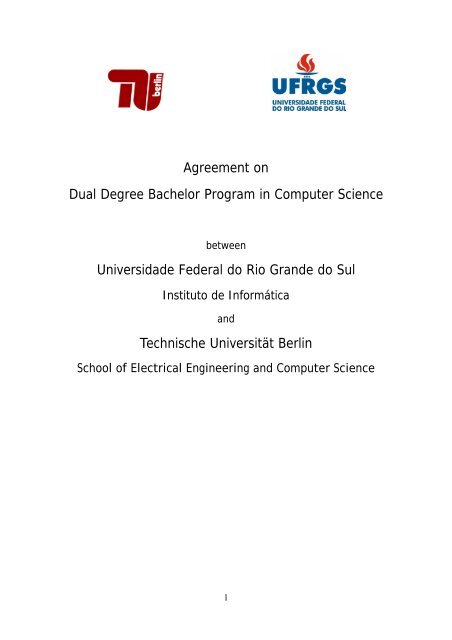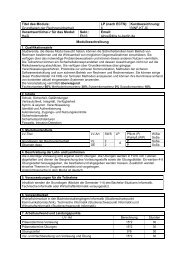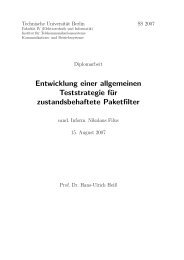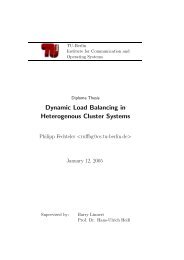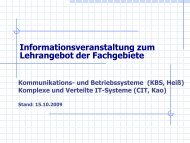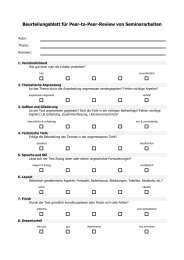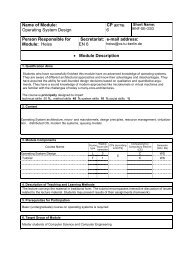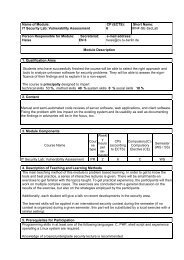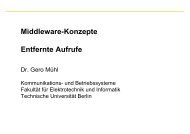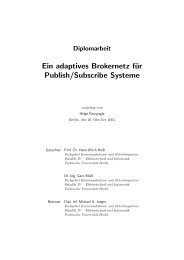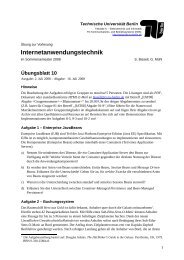Agreement on Dual Degree Bachelor Program in ... - TU Berlin
Agreement on Dual Degree Bachelor Program in ... - TU Berlin
Agreement on Dual Degree Bachelor Program in ... - TU Berlin
You also want an ePaper? Increase the reach of your titles
YUMPU automatically turns print PDFs into web optimized ePapers that Google loves.
<str<strong>on</strong>g>Agreement</str<strong>on</strong>g> <strong>on</strong><strong>Dual</strong> <strong>Degree</strong> <strong>Bachelor</strong> <strong>Program</strong> <strong>in</strong> Computer SciencebetweenUniversidade Federal do Rio Grande do SulInstituto de InformáticaandTechnische Universität Berl<strong>in</strong>School of Electrical Eng<strong>in</strong>eer<strong>in</strong>g and Computer Science1
PreambleWith<strong>in</strong> the scope of this agreement, the term Instituti<strong>on</strong> describes the follow<strong>in</strong>g entities, namely,Technische Universität Berl<strong>in</strong> (hereafter referred to as <strong>TU</strong>B) and Universidade Federal do RioGrande de Sul (hereafter referred to as UFRGS).1 Subject of the agreement and aimsThis agreement describes the academic and adm<strong>in</strong>istrative c<strong>on</strong>diti<strong>on</strong>s c<strong>on</strong>cern<strong>in</strong>g the realizati<strong>on</strong> ofa dual degree program support<strong>in</strong>g the exchange of students between UFRGS, Instituto deInformática, and <strong>TU</strong>B, School of Electrical Eng<strong>in</strong>eer<strong>in</strong>g and Computer Science. The aim is to enable<strong>TU</strong>B students and UFRGS students of Computer Science to receive degrees of both universities(“<strong>Bachelor</strong> of Science <strong>in</strong> Informatik” and “Bacharel em Ciência da Computação”). This agreement isbased <strong>on</strong> the pr<strong>in</strong>ciple that the participat<strong>in</strong>g students have to fulfill the requirements of both studyprograms.1.1 Scope of agreementThis agreement applies to <strong>TU</strong>B students <strong>in</strong> the <strong>Bachelor</strong> <strong>Program</strong> <strong>in</strong> Computer Science and UFRGSstudents <strong>in</strong> the <strong>Bachelor</strong> <strong>Program</strong> <strong>in</strong> Computer Science.1.2 Acknowledgment of student's achievements <strong>on</strong> enter<strong>in</strong>g the dual degree programOn the assumpti<strong>on</strong> of fundamental equivalence and based <strong>on</strong> mutual trust <strong>in</strong> the academic qualityof the host university's curriculum it is agreed that:<strong>TU</strong>B acknowledges the qualificati<strong>on</strong> for university entrance to UFRGS and the successfullycompleted first five semesters <strong>in</strong> the UFRGS Computer Science program as the entryrequirement for third year’s study at <strong>TU</strong>B.UFRGS acknowledges the qualificati<strong>on</strong> for university entrance to <strong>TU</strong>B and the successfullycompleted first four semesters <strong>in</strong> the <strong>TU</strong>B Computer Science program as the entryrequirement for fourth’s year’s study at UFRGS.To make sure that the obligatory body of knowledge of both universities is covered by all studentsof that dual-degree-program, miss<strong>in</strong>g mandatory subjects of the host university must be made uplater (see appendix).2 Admissi<strong>on</strong> procedure2.1 Selecti<strong>on</strong>Both parties guarantee that participants of the dual degree program will be selected accord<strong>in</strong>g totheir academic, pers<strong>on</strong>al, and l<strong>in</strong>guistic qualificati<strong>on</strong>s. To enter the dual degree program, studentshave to be enrolled <strong>in</strong> the respective CS <strong>Bachelor</strong> <strong>Program</strong> at their home <strong>in</strong>stituti<strong>on</strong>. Applicati<strong>on</strong>sare evaluated first by the home <strong>in</strong>stituti<strong>on</strong> and then presented to the partner <strong>in</strong>stituti<strong>on</strong> (which willbecome the student's host <strong>in</strong>stituti<strong>on</strong>) for review and approval.2.2 Admissi<strong>on</strong> requirementsStudents from UFRGS can be admitted, ifthey have successfully completed the coursework of the first 5 semesters of the UFRGS studyprogramthey have achieved an average grade of B2
they have proved sufficient knowledge of German (DSH or TestDaF level TDN4) 1 .Students from <strong>TU</strong>B can be admitted, if they have successfully completed the coursework of the first 4 semesters of the <strong>TU</strong>B studyprogram they have achieved an average grade of at least 2.5 they have proved sufficient knowledge of Portuguese accord<strong>in</strong>g to the requirements of theBrazilian M<strong>in</strong>istry of Eduati<strong>on</strong> (CELPE-Bras, level “Intermediário Superior”) 2 .3 Curricular c<strong>on</strong>diti<strong>on</strong>s3.1 General c<strong>on</strong>diti<strong>on</strong>sStudents from both sides are required to study 2/3 of their respective study program at their home<strong>in</strong>stituti<strong>on</strong>. At least 3 semesters must be spent at the host <strong>in</strong>stituti<strong>on</strong>. That means, UFRGS studentsstudy 6 semester at UFRGS and 3 semesters at <strong>TU</strong>B, <strong>TU</strong>B students study 4 semesters at <strong>TU</strong>B and 3semesters at UFRGS. <strong>TU</strong>B students will therefore need <strong>on</strong>e semester more to obta<strong>in</strong> the dual degreecompared to obta<strong>in</strong><strong>in</strong>g <strong>TU</strong>B degree <strong>on</strong>ly.Credit po<strong>in</strong>ts: If a c<strong>on</strong>versi<strong>on</strong> of credit po<strong>in</strong>ts is necessary, the follow<strong>in</strong>g c<strong>on</strong>versi<strong>on</strong> rate is used:1 credit (UFRGS) = 1.2 ECTS (<strong>TU</strong>B). 3Course overlap. The courses attended at both <strong>in</strong>stituti<strong>on</strong>s may overlap <strong>on</strong>ly slightly.Sem<strong>in</strong>ar and project course (<strong>TU</strong>B) and F<strong>in</strong>al Project I (UFRGS). The <strong>in</strong>tenti<strong>on</strong> of the<strong>in</strong>clusi<strong>on</strong> of a project and sem<strong>in</strong>ar <strong>in</strong> the <strong>TU</strong>B curriculum is to prepare the students for the <strong>Bachelor</strong>thesis. Likewise, the F<strong>in</strong>al Project I of the UFGRS curriculum prepares for the F<strong>in</strong>al Project II.Therefore, <strong>TU</strong>B recognizes the F<strong>in</strong>al Project I as equivalent to a comb<strong>in</strong>ed project / sem<strong>in</strong>armodule at <strong>TU</strong>B.<strong>Bachelor</strong> thesis and F<strong>in</strong>al Project II. The <strong>Bachelor</strong> thesis (<strong>TU</strong>B) and the F<strong>in</strong>al Project II arec<strong>on</strong>sidered equivalent. <strong>TU</strong>B acknowledges the successful completi<strong>on</strong> of the F<strong>in</strong>al Project II asfulfillment of all requirements of a <strong>Bachelor</strong> thesis. Before start<strong>in</strong>g the F<strong>in</strong>al Project II, the <strong>TU</strong>Bcoord<strong>in</strong>ator should approve the title and the task descripti<strong>on</strong>. The Project document can be written<strong>in</strong> Portuguese, <strong>in</strong> German or <strong>in</strong> English. In case of Portuguese or German, an English summarymust be provided.Specializati<strong>on</strong> area of <strong>TU</strong>B <strong>Program</strong>. UFRGS students may choose Communicati<strong>on</strong> Technology(CT) or Software Technology (ST) as the specializati<strong>on</strong> area at <strong>TU</strong>B. <strong>TU</strong>B students must chooseSoftware Technology (ST).M<strong>in</strong>or subject at <strong>TU</strong>B and supplementary credits at UFRGS. With the m<strong>in</strong>or subject at <strong>TU</strong>B(m<strong>in</strong>. 12 ECTS) students have fulfilled the requirement of supplementary credits (8 CP) at UFRGSLearn<strong>in</strong>g <str<strong>on</strong>g>Agreement</str<strong>on</strong>g>. After admissi<strong>on</strong> to the program, students have to submit an <strong>in</strong>dividualstudy program that needs to be approved by the program coord<strong>in</strong>ator of the home university andthe program coord<strong>in</strong>ator of the host university. The program should specify which courses will betaken by the student. In justified cases, the study program can be modified. The changes requirethe approval of the coord<strong>in</strong>ators of both universities.3.2 <strong>Program</strong> descripti<strong>on</strong>1 For selecti<strong>on</strong> and admissi<strong>on</strong>, a lower language proficiency (level B1) may be sufficient. However, the requiredcertificate must be submitted dur<strong>in</strong>g the stay at the host university.2 For selecti<strong>on</strong> and admissi<strong>on</strong>, a lower language proficiency (<strong>in</strong>termediário) may be sufficient. However, therequired certificate must be submitted dur<strong>in</strong>g the stay at the host university.3 This c<strong>on</strong>versi<strong>on</strong> rate is based <strong>on</strong> an average for regular studies of 25 credits per semester at UFRGS comparedto 30 ECTS at <strong>TU</strong>B.3
3.2.1 Requirements of UFRGSThe recommended plan of study for regular UFRGS students takes 4 years and a half (9 semesters).To obta<strong>in</strong> the <strong>Bachelor</strong>’s degree UFRGS students must earn at least 218 UFRGS credits, c<strong>on</strong>sist<strong>in</strong>g of mandatory courses (37 courses that give 158 credits) 32 credits which can be obta<strong>in</strong>ed with any selecti<strong>on</strong> of elective courses 8 credits with supplementary activities obta<strong>in</strong>ed with work as a research assistant,tra<strong>in</strong>eeship, courses, etc. f<strong>in</strong>al project (part I - 8 credits, and part II 12 credits) – with a supervisor and defense for apanel of three lecturers3.2.2 Requirements of <strong>TU</strong>BThe recommended plan of study for regular <strong>TU</strong>B students takes 3 years (6 semesters). To obta<strong>in</strong> the<strong>Bachelor</strong>’s degree <strong>TU</strong>B students must earn at least 180 ECTS credits, c<strong>on</strong>sist<strong>in</strong>g of mandatory modules (132 ECTS) a <strong>Bachelor</strong> Thesis (12 ECTS) with a supervisor and defense selecti<strong>on</strong> of elective courses either <strong>in</strong> Software or <strong>in</strong> Communicati<strong>on</strong> Technology, worth atleast 21 ECTS Courses from a m<strong>in</strong>or subject, worth at least 12 ECTSIncluded <strong>in</strong> the courses must be a sem<strong>in</strong>ar and a project.3.3 Requirements for the Double-<strong>Degree</strong> <strong>Program</strong>3.3.1 Students from UFRGSThe program structure is as follows.- Semester 1-5 <strong>in</strong> the undergraduate CS program at UFRGS.- 3 semesters of study <strong>in</strong> CS <strong>Bachelor</strong> program at <strong>TU</strong>B accord<strong>in</strong>g to the appendix3.3.2 Students of <strong>TU</strong> Berl<strong>in</strong>The program structure is as follows.- Semesters 1-4 <strong>in</strong> the CS <strong>Bachelor</strong> program at <strong>TU</strong> Berl<strong>in</strong>.- 3 semesters of study <strong>in</strong> the undergraduate program at UFRGS accord<strong>in</strong>g to the appendix.3.4 Exam<strong>in</strong>ati<strong>on</strong> regulati<strong>on</strong>sDur<strong>in</strong>g the studies of UFRGS students at <strong>TU</strong>B, the exam<strong>in</strong>ati<strong>on</strong> regulati<strong>on</strong>s (Prüfungsordnung) of<strong>TU</strong>B apply <strong>in</strong> the current versi<strong>on</strong>.Dur<strong>in</strong>g the studies of <strong>TU</strong>B students at UFRGS, the exam<strong>in</strong>ati<strong>on</strong> regulati<strong>on</strong>s of UFRGS apply <strong>in</strong> thecurrent versi<strong>on</strong>.If a student is expelled from the course accord<strong>in</strong>g to the rules of the host university, she or he isalso expelled from the dual-degree program. He or she may, however, f<strong>in</strong>ish the program at thehome university.Both partner <strong>in</strong>stituti<strong>on</strong>s will hand out a transcript of records <strong>in</strong> English to students. The Transcriptof Records is an official <strong>in</strong>ventory of the courses taken, the achieved number of ECTS credit po<strong>in</strong>ts,and nati<strong>on</strong>al grades earned by the students throughout their stay <strong>in</strong> the host <strong>in</strong>stituti<strong>on</strong>. Details ofthe grad<strong>in</strong>g schemes can be found <strong>in</strong> Appendix B.After successful completi<strong>on</strong> of the complete program at both universities, the participat<strong>in</strong>g studentsreceive the <strong>Bachelor</strong>’s degree of both universities. Students will receive a B.Sc. degree <strong>in</strong> the fieldof "Computer Science" from <strong>TU</strong>B and from UFRGS.The f<strong>in</strong>al certificate and the f<strong>in</strong>al grade issued by <strong>TU</strong>B will be based <strong>on</strong> the <strong>TU</strong>B requirements.Mandatory courses of the <strong>TU</strong>B curriculum can be replaced by equivalent courses of UFRGS (seeappendix). Courses exceed<strong>in</strong>g 180 ECTS can be listed <strong>in</strong> the certificate as supplementary modules,4
ut are not c<strong>on</strong>tribut<strong>in</strong>g to the f<strong>in</strong>al grade. They, however, could be recognized <strong>in</strong> a subsequentMaster <strong>Program</strong> if appropriate.The f<strong>in</strong>al certificate issued by UFRGS will be based <strong>on</strong> the UFRGS requirements. Mandatory coursesof the UFRGS can be replaced by equivalent courses of <strong>TU</strong>B accord<strong>in</strong>g to the appendix.4 Organizati<strong>on</strong>al arrangements4.1 Exchange c<strong>on</strong>t<strong>in</strong>gentUp to five students are to be accepted by the host <strong>in</strong>stituti<strong>on</strong> per year. This number may bechanged with mutual c<strong>on</strong>sent of both <strong>in</strong>stituti<strong>on</strong>s without the need to change this c<strong>on</strong>tract.4.2 <strong>Program</strong> coord<strong>in</strong>atorBoth <strong>in</strong>stituti<strong>on</strong>s appo<strong>in</strong>t a program coord<strong>in</strong>ator resp<strong>on</strong>sible for the implementati<strong>on</strong> of the program.In case of any difficulties the two program coord<strong>in</strong>ators are expected to solve the problems bymutual c<strong>on</strong>sent.4.3 F<strong>in</strong>ancial regulati<strong>on</strong>sStudents participat<strong>in</strong>g <strong>in</strong> this dual degree program will pay their normal registrati<strong>on</strong> fees at theirhome universities. Dur<strong>in</strong>g the term of the agreement, the host <strong>in</strong>stituti<strong>on</strong> agrees to waive all tuiti<strong>on</strong>fees for <strong>in</strong>com<strong>in</strong>g students under this agreement.However, student may have to pay a small student registrati<strong>on</strong> fee at the host <strong>in</strong>stituti<strong>on</strong>.The host university will arrange for accommodati<strong>on</strong> <strong>in</strong> a student dormitory, if possible.4.4 Travel and accomodati<strong>on</strong>Participants of the dual degree program are resp<strong>on</strong>sible for their own travel and liv<strong>in</strong>g expensesdur<strong>in</strong>g the exchange, if there is no third party fund<strong>in</strong>g. The home as well as the host <strong>in</strong>stituti<strong>on</strong>will, however, try to get f<strong>in</strong>ancial support to defray all or part of those expenses.5. Changes to this agreementThe equivalence tables <strong>in</strong> the appendix can be changed by mutual accordance without chang<strong>in</strong>gthis agreement.Technische Universität Berl<strong>in</strong>Date:UFRGSDate:________________________Prof. Dr. Kurt KutzlerPresident_____________________________Rector______________________________Prof. Dr. Hans-Ulrich HeißDean of Studies, School of EE&CS___________________________________Director of Institute5
APPENDIX APROGRAM DETAILSA.1 Mutual recogniti<strong>on</strong> of mandatory courses/modulesIn this secti<strong>on</strong>, it is expla<strong>in</strong>ed, how the subjects of the mandatory courses of both programs arecovered by respective courses of the partner university. It is understood that there is no exactcorresp<strong>on</strong>dence neither <strong>in</strong> the subject nor <strong>in</strong> the depth of coverage. Nevertheless, the tables makeclear that all major topics are covered by both programs. Table A-1 lists the mandatory courses ofUFRGS and shows the respective <strong>TU</strong>B modules. Table A-2 lists the mandatory modules of <strong>TU</strong>B andshows the respective UFRGS courses. To compile the f<strong>in</strong>al degree certificate of <strong>TU</strong>B, thiscorresp<strong>on</strong>dence table A-2 will be used <strong>in</strong>clud<strong>in</strong>g the calculati<strong>on</strong> of grades. If a <strong>TU</strong>B modulecorresp<strong>on</strong>ds to 2 UFGRS courses, the arithmetic mean of both UFRGS grades will be used to build thecorresp<strong>on</strong>d<strong>in</strong>g <strong>TU</strong>B grade.Courses taken at <strong>TU</strong>B or UFRGS that are <strong>in</strong> excess of the required 180 ECTS for the <strong>TU</strong>B degree canbe listed <strong>in</strong> the <strong>TU</strong>B degree certificate as supplementary modules <strong>on</strong> the student’s request. They maybe recognized <strong>in</strong> a subsequent Master’s program at <strong>TU</strong>B. Courses taken at <strong>TU</strong>B or UFRGS that are <strong>in</strong>excess of the required 218 credits for the UFRGS degree will be listed <strong>in</strong> the UFRGS degree certificateas complementary credits.UFRGS-CodeCP English title <strong>TU</strong>B-Code <strong>TU</strong>B coursesINF01202 6 Algorithms and <strong>Program</strong>m<strong>in</strong>g BINF-GL-MPGI2Datenstrukturen und Algorithmen imimperativen StilData Structures and Algorithms <strong>in</strong>Imperative StyleMAT01353 6Calculus and AnalyticGeometry IBINF-GL-Ana1INF05008 4 Introducti<strong>on</strong> to Algorithms BINF-GL-MPGI1INF01107 4Introducti<strong>on</strong> to ComputerArchitectureBINF-GL-TechGI1BINF-GL-TechGI2MAT01375 4 Discrete Mathematics BINF-GL-TheGI1MAT01355 4 L<strong>in</strong>ear Algebra BINF-GL-LAAnalysis IAlgorithmische und funkti<strong>on</strong>aleLösung diskreter ProblemeAlgorithmic and Functi<strong>on</strong>al Soluti<strong>on</strong>of Discrete ProblemsDigitale SystemeDigital Systems+Rechnerorganisati<strong>on</strong>Computer Organizati<strong>on</strong>Grundlagen und algebraischeStrukturenFoundati<strong>on</strong>s and AlgebraicStructuresL<strong>in</strong>eare AlgebraL<strong>in</strong>ear AlgebraINF01108 4Computer Architecture andOrganizati<strong>on</strong> IBINF-GL-TechGI2Rechnerorganisati<strong>on</strong>Computer Organizati<strong>on</strong>MAT01354 6Calculus and AnalyticGeometry IIBINF-GL-Ana2INF01203 6 Data Structures BINF-GL-MPGI2INF05508 4 Logic for Computer Science BINF-GL-TheGI3INF05512 4Graph Theory andComb<strong>in</strong>atorial AnalysisAnalysis IIDatenstrukturen und Algorithmen imimperativen StilData Structures and Algorithms <strong>in</strong>Imperative StyleLogik und KalküleLogic and Calculi-6
INF01112 4Computer Architecture andOrganizati<strong>on</strong> IIBINF-GL-TechGI2BINF-GL-TechGI3INF01124 4 Data Sort<strong>in</strong>g and Search<strong>in</strong>g BINF-GL-MPGI4INF05512 4INF05005 4Symbolic and NumericComputati<strong>on</strong>Formal Languages andAutomataBINF-GL-TheGI2MAT02219 4 Probability and Statistics BINF-GL-StochInfINF01118 6Digital Techniques forComputer ScienceBINF-GL-TechGI1INF05501 4 Theory of Computati<strong>on</strong> BINF-GL-TheGI2INF05006 4 Computati<strong>on</strong>al Categories BINF-GL-TheGI1INF05515 4 Algorithmic ComplexityBINF-GL-MPGI2BINF-GL-TheGI1INF01145 4 Introducti<strong>on</strong> to Databases BINF-GL-MPGI5Rechnerorganisati<strong>on</strong>Computer Organizati<strong>on</strong>+SystemprogrammierungSystem <strong>Program</strong>m<strong>in</strong>gPraxis der <strong>Program</strong>mentwicklungPractical <strong>Program</strong> development-Automaten und KomplexitätAutomata andComplexityStochastik für InformatikerStochasticsDigitale SystemeDigital SystemsAutomaten und KomplexitätAutomata andComplexityGrundlagen und algebraischeStrukturenFoundati<strong>on</strong> and AlgebraicStructuresDatenstrukturen und Algorithmen imimperative StilData Structures and Algorithms <strong>in</strong>Imperative Style+Grundlagen und AlgebraischeStrukturenFound. & AlgebraicStructuresDatenbanksystemeDatabase SystemsINF01046 4Introducti<strong>on</strong> to ImageProcess<strong>in</strong>gBINF-SWT-CGCVComputer Graphics / ComputerVisi<strong>on</strong> (Elective)INF01113 4 Computer Organizati<strong>on</strong> -INF01120 4 TCP <strong>Program</strong>m<strong>in</strong>g Project BINF-GL-MPGI3 Software ProjectINF01127 4 Software Eng<strong>in</strong>eer<strong>in</strong>g I BINF-GL-MPGI3INF01047 4Introducti<strong>on</strong> to ComputerGraphicsBINF-SWT-CGCVINF01048 4 Artificial Intelligence BINF-SWT-KIINF01121 4<strong>Program</strong>m<strong>in</strong>g LanguageParadigms7SoftwaretechnikSoftware Eng<strong>in</strong>eer<strong>in</strong>gComputer Visi<strong>on</strong> / ComputerGraphics(Elective)Künstliche Intelligenz: Grundlagenund AnwendungenArtificial Intelligence(Elective)INF05010 4 Comb<strong>in</strong>atorial Optimizati<strong>on</strong> -INF05516 4Formal Semantics of<strong>Program</strong>m<strong>in</strong>g LanguagesBINF-GL-TheGI4BINF-KT-SuKINF01142 4 Operat<strong>in</strong>g Systems I BINF-GL-TechGI3-Spezifikati<strong>on</strong> und SemantikSpecificati<strong>on</strong> andSemantics +Semantik und KalküleSemantic and Calculi(Elective)SystemprogrammierungSystem <strong>Program</strong>m<strong>in</strong>g
INF01147 4 Compilers MINF-SE-ÜBB1INF01209 4 Introducti<strong>on</strong> to Fault Tolerance MINF-SE-EOSCompilerbau 1Compiler c<strong>on</strong>structi<strong>on</strong> 1(Master program)Dependable Systems(Master <strong>Program</strong>)INF01043 4 Human-Mach<strong>in</strong>e Interacti<strong>on</strong> BINF-KT-Usability Usability Eng<strong>in</strong>eer<strong>in</strong>gINF01154 6 Computer Networks BINF-GL-TechGI4INF01151 4 Operat<strong>in</strong>g Systems IIBINF-GL-TechGI3BINF-GL-TechGI4INF01032 4 Entrepeneur <strong>in</strong> Informatics B-GL-GdMRechnernetze und VerteilteSystemeComputer Networks and DistributedSystemsSystemprogrammierungSystem <strong>Program</strong>m<strong>in</strong>g+Rechnernetze und VerteilteSystemeComputer Networks and Distrib.SystemsGrundlagen des ManagementManagementINF99001 8 Graduati<strong>on</strong> Project I Sem<strong>in</strong>ar + Project at <strong>TU</strong>BINF99002 12 Graduati<strong>on</strong> Project II <strong>Bachelor</strong>'s thesis at <strong>TU</strong>BTable A-1: Corresp<strong>on</strong>dence of <strong>TU</strong>B modules to mandatory UFRGS courses<strong>TU</strong>B-Code ECTS <strong>TU</strong>B coursesUFRGS-CodeBINF-GL-Ana1 8 Analysis I MAT01353BINF-GL-Ana2 8 Analysis II MAT01354BINF-GL-LA 6 L<strong>in</strong>ear Algebra MAT01355UFRGS Course NameCÁLCULO E GEOMETRIA ANALÍTICA I- ACalculus and Analytic Geometry ICÁLCULO E GEOMETRIA ANALÍTICAII - ACalculus and Analytic Geometry IIÁLGEBRA LINEAR I - AL<strong>in</strong>ear AlgebraBINF-GL-Prop 2Informatik-PropädeutikumMAT01375MATEMÁTICA DISCRETA BDiscrete MathematicsBINF-GL-MPGI1 9Algorithmic andFuncti<strong>on</strong>al Soluti<strong>on</strong> ofDiscrete ProblemsINF05008FUNDAMENTOS DE ALGORITMOSIntroducti<strong>on</strong> to AlgorithmsBINF-GL-MPGI2BINF-GL-MPGI3BINF-GL-MPGI4 69 Data Structures andAlgorithms <strong>in</strong>Imperative Style6SoftwareEng<strong>in</strong>eer<strong>in</strong>gINF01202INF01203INF011276 Software-Project INF01120Practical <strong>Program</strong>DevelopmentINF01124ALGORÍTMOS E PROGRAMAÇÃO -CICAlgorithms and <strong>Program</strong>m<strong>in</strong>gESTRU<strong>TU</strong>RAS DE DADOSData StructuresENGENHARIA DE SOFTWARE NSoftware Eng<strong>in</strong>eer<strong>in</strong>g ITÉCNICAS DE CONSTRUÇÃO DEPROGRAMASTCP <strong>Program</strong>m<strong>in</strong>g ProjectCLASSIFICAÇÃO E PESQUISA DEDADOSData Sort<strong>in</strong>g and Search<strong>in</strong>g8
BINF-GL-MPGI5 6Database SystemsINF01145BINF-GL-StochInf 6 Stochastics MAT02219FUNDAMENTOS DE BANCO DEDADOSIntroducti<strong>on</strong> to DatabasesPROBABILIDADE E ESTATÍSTICAProbability and StatisticsBINF-GL-TechGI1BINF-GL-TechGI266DigitalSystemsComputerOrganizati<strong>on</strong>INF01107INF01118INF01108INF01112INTRODUÇÃO À ARQUITE<strong>TU</strong>RA DECOMPUTADORESIntroducti<strong>on</strong> to Computer ArchitectureTÉCNICAS DIGITAIS PARACOMPUTAÇÃODigital Techniques for ComputerScienceARQUITE<strong>TU</strong>RA E ORGANIZAÇÃO DECOMPUTADORES IComputer Architecture and Organizati<strong>on</strong>IARQUITE<strong>TU</strong>RA E ORGANIZAÇÃO DECOMPUTADORES IIComputer Architecture and Organizati<strong>on</strong>IIBINF-GL-TechGI3 4System<strong>Program</strong>m<strong>in</strong>gINF01142SISTEMAS OPERACIONAIS I NOperat<strong>in</strong>g Systems IBINF-GL-TechGI46Computer Networksand Distrib. SystemsINF01154INF01151SISTEMAS OPERACIONAIS I NComputer NetworksSISTEMAS OPERACIONAIS II NOperat<strong>in</strong>g Systems IIBINF-GL-TheGI1 6Found. & AlgebraicStructuresINF05006CATEGORIAS COMPUTACIONAIS NComputati<strong>on</strong>al CategoriesBINF-GL-TheGI26Automata andComplexityINF05005INF05501LINGUAGENS FORMAIS EAUTÔMATOS NFormal Languages and AutomataTEORIA DA COMPUTAÇÃO NTheory of Computati<strong>on</strong>BINF-GL-TheGI3 6Logic and CalculiINF05508LÓGICA PARA COMPUTAÇÃOLogic for Computer ScienceBINF-GL-TheGI4 6 Specificati<strong>on</strong> andSemanticsINF05516SEMÂNTICA FORMAL NFormal Semantics of <strong>Program</strong>m<strong>in</strong>gLanguagesB-GL-GdM 4 Management INF01032EMPREENDIMENTO EMINFORMÁTICAEntrepeneur <strong>in</strong> InformaticsBINF-GL-IR 6Informatik undGesellschaftINF01140COMPUTADOR E SOCIEDADEComputers and Society9Sem<strong>in</strong>ar + Project at<strong>TU</strong>BINF99001TRABALHO DE GRADUAÇÃO IGraduati<strong>on</strong> Project I12<strong>Bachelor</strong>'s thesis at<strong>TU</strong>BINF99002TRABALHO DE GRADUAÇÃO IIGraduati<strong>on</strong> Project IITable A-2: Corresp<strong>on</strong>dence of UFRGS courses to mandatory <strong>TU</strong>B modules9
A.2 Requirements of Students from UFRGS com<strong>in</strong>g to <strong>TU</strong>BThis secti<strong>on</strong> lists the recommended course of studies for students from UFRGS com<strong>in</strong>g to <strong>TU</strong>B. UFRGSstudents com<strong>in</strong>g to <strong>TU</strong>B after 5 semesters have already collected at least 132 CP as mandatorycourses. S<strong>in</strong>ce they will f<strong>in</strong>ish their studies back at UFRGS with the Graduati<strong>on</strong> Project II (12 CP), theywill need to take 74 CP, corresp<strong>on</strong>d<strong>in</strong>g to 89 ECTS, at <strong>TU</strong>B. These credits must be composed suchthat they cover so far miss<strong>in</strong>g mandatory courses. Some of these mandatory courses are alsomandatory at <strong>TU</strong>B.The UFRGS students can choose from the follow<strong>in</strong>g opti<strong>on</strong>s:6 mandatory courses (30 CP / 36 ECTS) (Table A-3)2 courses (10 CP / 12 ECTS) from an applicati<strong>on</strong> area (Requirement of <strong>TU</strong>B, recognized as“supplementary credits” at UFRGS) (Table A-4)26 CP from the list of elective courses offered by <strong>TU</strong>B (Table A-5)Sem<strong>in</strong>ar + Project and <strong>Bachelor</strong>’s thesis (Table A-2)UFRGS student have to complete the follow<strong>in</strong>g courses, which are mandatory, either at <strong>TU</strong>B or atUFRGS (Table A-3).Course workECTSUsage for<strong>TU</strong> Berl<strong>in</strong>Usage for UFRGS(recognized as equivalentto …)TechGI4 (Introducti<strong>on</strong> to ComputerNetworks and Distributed Systems)6 mandatory mandatory (ComputerNetworks)Grundlagen des Management 6 mandatory mandatory(Entrepreneur <strong>in</strong> Informatics)Informatik und Gesellschaft 6 mandatory elective(Computers and Society)Compilerbau 1 (CS Master’s program) 6 supplementary mandatory(Compilers)Embedded Operat<strong>in</strong>g Systems (CS6 supplementary mandatoryMaster’s program)(Fault Tolerance)Usability Eng<strong>in</strong>eer<strong>in</strong>g 6 supplementary mandatory(Human-Mach<strong>in</strong>e Interacti<strong>on</strong>)CP555555Table A-3: Mandatory courses of UFRGS students at <strong>TU</strong>BIn additi<strong>on</strong> to these mandatory courses, UFRGS students have to choose <strong>on</strong>e field of applicati<strong>on</strong>, fromwhich they have to take courses to the amount of at least 12 ECTS and at most 15 ECTS. Thecurrently offered fields of applicati<strong>on</strong> are listed <strong>in</strong> Table A-4.MathematicsElectrical Eng<strong>in</strong>eer<strong>in</strong>gTraffic SystemsIT for Develop<strong>in</strong>g CountriesEc<strong>on</strong>omicsProducti<strong>on</strong> Eng<strong>in</strong>eer<strong>in</strong>gStatisticsSociologyEmpirical Social SciencesTable A-4: Offered applicati<strong>on</strong> areas students at <strong>TU</strong>BIn additi<strong>on</strong>, they may choose from the follow<strong>in</strong>g list of elective modules (Table A-5) to meet the creditpo<strong>in</strong>t requirements of UFRGS.10
Course workECTSUsage for<strong>TU</strong> Berl<strong>in</strong>Usage forUFRGSCP<strong>Bachelor</strong>-Projekt CIT mit Sem<strong>in</strong>ar 9 elective (CT) elective 7Semantik und Kalküle6 elective (CT) elective 5(Semantics and Calculi)Modellierung und Entwicklung offener verteilter System 12 elective (CT) elective 10(Model<strong>in</strong>g and development of open distributedsystems)Betriebsystempraktikum (Operat<strong>in</strong>g System Lab) 6 elective (CT) elective 5Sicherheit (Computer Security) 6 elective (CT) elective 5Verteilte Systeme (Distributed Systems) 6 elective (CT) elective 5KBS-<strong>Bachelor</strong>-Projekt 9 elective (CT) elective 7Kommunikati<strong>on</strong>snetze (Communicati<strong>on</strong> Networks) 6 elective (CT) elective 5Kommunikati<strong>on</strong>snetze-Praktische Vertiefung9 elective (CT) elective 7(Communicati<strong>on</strong> Networks + Lab)Netzwerkarchitekturen- <strong>Bachelor</strong> Praxis 9 elective (CT) elective 7Praktikum Rechnersicherheit (Computer Security Lab) 6 elective (CT) elective 5E<strong>in</strong>führung <strong>in</strong> die Kogniti<strong>on</strong>swissenschaft (Introducti<strong>on</strong> 6 elective (CT) elective 5to Cognitive Science)Mobile Interacti<strong>on</strong> 6 5Agentenorientierte Techniken (Agent Technology) 6 elective (ST) elective 5Service Eng<strong>in</strong>eer<strong>in</strong>g 12 elective (ST) elective 106 elective (ST) elective 5Datenbankprojekt (Database Project)(DatabaseProject)Datenbankpraktikum (Database Lab) 6 elective (ST) elective 5Data Warehous<strong>in</strong>g und Bus<strong>in</strong>ess Intelligence 6 elective (ST) elective 5Implementati<strong>on</strong> of Database Systems 12 elective (ST) elective 10Advanced Informati<strong>on</strong> Model<strong>in</strong>g 6 elective (ST) elective 5Intelligente Datenanalyse (Intelligent data analysis) 6 elective (ST) elective 5Projekt Intelligente Datenanalyse 9 elective (ST) elective 7Objektorientierte Softwareentwicklung (Object Oriented 6 elective (ST) elective 5Software Development)Qualitätssicherungs-Praxis (Software Quality6 elective (ST) elective 5Assurance)E<strong>in</strong>führung <strong>in</strong> die Systemanalyse (Introducti<strong>on</strong> to6 elective (ST) elective 5System Analysis)Systemanalyse Kle<strong>in</strong>projekt (System Analysis Small 6 elective (ST) elective 5Project)Visuelle Sprachen (Visual Languages) 6 elective (ST) elective 5Visuelle Sprachen (Visual Languages+ Sem<strong>in</strong>ar) 9 elective (ST) elective 5Formale Modellierung und Kompositi<strong>on</strong>alität -6 elective (ST) elective 5prozessorientierter SystemeFormale Modellierung und Kompositi<strong>on</strong>alität-9 elective (ST) elective 7prozessorientierter Systeme- SESoftware Horror Stories 6 elective (ST) elective 5Table A-5: Elective courses for UFRGS students at <strong>TU</strong>BIn additi<strong>on</strong> to the <strong>Bachelor</strong>’s program courses, UFRGS may also select from the CS Master’s program.This selecti<strong>on</strong> is subject to approval of the two program’ coord<strong>in</strong>ators. The courses already attendedby UFRGS students <strong>in</strong> the first five semesters at UFRGS, can be recognized for the Computer Scienceelectives at <strong>TU</strong>B accord<strong>in</strong>g to table A-6.11
A.3 Requirements of Students from <strong>TU</strong>B com<strong>in</strong>g to UFRGS<strong>TU</strong>B students com<strong>in</strong>g to UFRGS are expected to complete 1/3 of the UFRGS curriculum at UFRGS,which amounts to 72 CP. They also have to take mandatory subjects of the UFRGS program that arenot covered by the <strong>TU</strong>B program studied so far. These 72 CP are composed <strong>in</strong> the follow<strong>in</strong>g way: 9 courses (36 CP) that are mandatory for UFRGS (Table A-6) 8 supplementary CP at UFRGS. These credits po<strong>in</strong>ts must be chosen from a m<strong>in</strong>or subject asrequired by <strong>TU</strong>B and are recognized as 12 ECTS for the m<strong>in</strong>or (Anwendungsfach) at <strong>TU</strong>B Graduati<strong>on</strong> project I (8 CP) which is recognized by <strong>TU</strong>B as Sem<strong>in</strong>ar + Project (Table A-6) Graduati<strong>on</strong> project II (12 CP) which is recognized by <strong>TU</strong>B as <strong>Bachelor</strong> Thesis (Table A-6) Additi<strong>on</strong>al courses (8 CP) to be selected from the elective courses offered at UFRGS (Table A-7)UFRGS Code Course work CPINF01047INF01048INF01043INF01121INF05010INF01147INF01209INF01032INF01140INF99001INF99002FUNDAMENTOS DE COMPUTAÇÃOGRÁFICAIntroducti<strong>on</strong> to Computer GraphicsINTELIGÊNCIA ARTIFICIALArtificial IntelligenceINTERAÇÃO HOMEM-COMPUTADORHuman-Mach<strong>in</strong>e Interacti<strong>on</strong>MODELOS DE LINGUAGEM DEPROGRAMAÇÃO<strong>Program</strong>m<strong>in</strong>g Language ParadigmsOTIMIZAÇÃO COMBINATÓRIAComb<strong>in</strong>atorial Optimizati<strong>on</strong>COMPILADORESCompilersFUNDAMENTOS DE TOLERÂNCIA AFALHASIntroducti<strong>on</strong> to Fault ToleranceEMPREENDIMENTO EM INFORMÁTICAEntrepeneur <strong>in</strong> InformaticsCOMPUTADOR E SOCIEDADE Computersand SocietyTRABALHO DE GRADUAÇÃO IGraduati<strong>on</strong> Project ITRABALHO DE GRADUAÇÃO IIGraduati<strong>on</strong> Project IISpecial Topic from chosen applicati<strong>on</strong>area (m<strong>in</strong>or subject) ISpecial Topic from chosen applicati<strong>on</strong>area (m<strong>in</strong>or subject) IITable A-6: Mandatory courses of <strong>TU</strong>B students at UFRGSUsage forUFRGSUsage for <strong>TU</strong>B(recognized asequivalent to …)ECTS4 mandatory elective (ST) 54 mandatory elective (ST) 54 mandatory elective (ST) 54 mandatory elective (ST) orsupplementary4 mandatory elective (ST) orsupplementary4 mandatory elective (ST) orsupplementary4 mandatory elective (ST) orsupplementary4 mandatory mandatory (equiv. to 5Management)4 elective mandatory 58 mandatory mandatory (equiv. toProject + Sem<strong>in</strong>ar)1012 mandatory mandatory (equiv. to 12<strong>Bachelor</strong> thesis)4 Electivemandatory 6Supplementarycredits4 electivemandatory 6Supplementarycredits555512
UFRGS Course Name CP Usage for <strong>TU</strong>B ECTSCodeINF01003 ENGENHARIA DE SOFTWARE II4 elective (ST) or5Software Eng<strong>in</strong>eer<strong>in</strong>g IIsupplementaryINF01001 ESPECIFICAÇÃO FORMAL N4 elective (ST) or5Formal Specificati<strong>on</strong>supplementaryINF01049 INTRODUÇÃO À PESQUISA EM INFORMÁTICA2 elective (ST) or2Introducti<strong>on</strong> to Informatics ResearchsupplementaryINF01017 REDES NEURAIS E SISTEMAS FUZZY4 elective (ST) or5Neural Networks and Fuzzy SystemssupplementaryINF01038 SISTEMAS ESPECIALISTAS N4 elective (ST) or5Expert SystemssupplementaryINF01191 ARQUITE<strong>TU</strong>RAS AVANÇADAS DE COMPUTADORES 4 elective (ST) or5Advanced Computer ArchitecturessupplementaryINF01146 AVALIAÇÃO DE DESEMPENHO4 elective (ST) or5High AvailabilitysupplementaryINF01205 CAD PARA SISTEMAS DIGITAIS4 elective (ST) or5CAD for Digital SystemssupplementaryINF01037 COMPUTAÇÃO EVOLUTIVA4 elective (ST) or5Evoluti<strong>on</strong>ary AlgorithmssupplementaryINF01009 COMPUTAÇÃO GRÁFICA4 elective (ST) or5Computer GraphicssupplementaryINF01005 COMUNICAÇÃO DE DADOS4 supplementary 5Data Communicati<strong>on</strong>INF01056 DESAFIOS DE PROGRAMAÇÃO4 elective (ST) or5<strong>Program</strong>m<strong>in</strong>g ChallengessupplementaryINF05001 LABORATÓRIO DE PROGRAMAÇÃO EM LÓGICA 4 elective (ST) or5Logical <strong>Program</strong>m<strong>in</strong>g LaboratorysupplementaryINF01008 PROGRAMAÇÃO DISTRIBUÍDA E PARALELA4 supplementary 5Parallel and Distributed <strong>Program</strong>m<strong>in</strong>gINF01006 PROJETO DE BANCO DE DADOS4 elective (ST) or5Database ProjectsupplementaryINF01002 PROTOCOLOS DE COMUNICAÇÃO4 supplementary 5Communicati<strong>on</strong> ProtoclosINF01034 ROBÓTICA II4 elective (ST) or5Robotics IIsupplementaryINF01179 TÓPICOS ESPECIAIS EM COMPUTAÇÃO I2 elective (ST) or5Special Topics <strong>in</strong> Comput<strong>in</strong>gsupplementaryINF01182 TÓPICOS ESPECIAIS EM COMPUTAÇÃO II2 elective (ST) or5Special Topics <strong>in</strong> Comput<strong>in</strong>gsupplementaryINF05009 TÓPICOS ESPECIAIS EM COMPUTAÇÃO IX4 elective (ST) or5Special Topics <strong>in</strong> Comput<strong>in</strong>gsupplementaryINF05504 TÓPICOS ESPECIAIS EM COMPUTAÇÃO V2 elective (ST) or5Special Topics <strong>in</strong> Comput<strong>in</strong>gsupplementaryINF01054 TÓPICOS ESPECIAIS EM COMPUTAÇÃO VII4 elective (ST) or5Special Topics <strong>in</strong> Comput<strong>in</strong>gsupplementaryINF01065 TÓPICOS ESPECIAIS EM COMPUTAÇÃO X2 elective (ST) or5Special Topics <strong>in</strong> Comput<strong>in</strong>gsupplementaryINF01064 TÓPICOS ESPECIAIS EM COMPUTAÇÃO XI2 elective (ST) or5Special Topics <strong>in</strong> Comput<strong>in</strong>gsupplementaryINF01063 TÓPICOS ESPECIAIS EM COMPUTAÇÃO XII4 elective (ST) or5Special Topics <strong>in</strong> Comput<strong>in</strong>gsupplementaryINF05011 TÓPICOS ESPECIAIS EM COMPUTAÇÃO XIII2 elective (ST) or5Special Topics <strong>in</strong> Comput<strong>in</strong>gsupplementaryINF05012 TÓPICOS ESPECIAIS EM COMPUTAÇÃO XIV2 elective (ST) or5Special Topics <strong>in</strong> Comput<strong>in</strong>gsupplementaryINF05013 TÓPICOS ESPECIAIS EM COMPUTAÇÃO XV4 elective (ST) or5Special Topics <strong>in</strong> Comput<strong>in</strong>gsupplementaryINF01016 GERÊNCIA E ADMINISTRAÇÃO DE PROJETOS4 elective (ST) or5Project ManagementsupplementaryINF01015 GERÊNCIA E APLICAÇÕES EM REDES 4 supplementary 513
INF05004INF01022INF01021INF01019INF01045INF01014INF01059INF01018INF05003INF01188INF01198INF05505INF01055INF05014INF01062INF01061INF01060INF05015INF05016Network Applicati<strong>on</strong>sINTELIGÊNCIA ARTIFICIAL AVANÇADAAdvanced Artificial IntelligenceLABORATÓRIO DE SISTEMA DE SOFTWARESoftware System LaboratoryPROJETO DE HIPERDOCUMENTOSHyperdocument ProjectPROJETO EM COMPUTAÇÃO GRÁFICAComputer Graphics ProjectSEGURANÇA EM SISTEMAS DE COMPUTAÇÃOComputer SecuritySISTEMAS DE BANCO DE DADOS DISTRIBUÍDOSDistributed Database SystemsSISTEMAS EMBARCADOSEmbedded SystemsSISTEMAS OPERACIONAIS DISTRIBUÍDOS E DEREDESDistributed and Network Operat<strong>in</strong>g SystemsTEORIA DA COMPUTAÇÃO DISTRIBUÍDATheory of Distributed Comput<strong>in</strong>gTÓPICOS ESPECIAIS EM COMPUTAÇÃO IIISpecial Topics <strong>in</strong> Comput<strong>in</strong>gTÓPICOS ESPECIAIS EM COMPUTAÇÃO IVSpecial Topics <strong>in</strong> Comput<strong>in</strong>gTÓPICOS ESPECIAIS EM COMPUTAÇÃO VISpecial Topics <strong>in</strong> Comput<strong>in</strong>gTÓPICOS ESPECIAIS EM COMPUTAÇÃO VIIISpecial Topics <strong>in</strong> Comput<strong>in</strong>gTÓPICOS ESPECIAIS EM COMPUTAÇÃO XIXSpecial Topics <strong>in</strong> Comput<strong>in</strong>gTÓPICOS ESPECIAIS EM COMPUTAÇÃO XVISpecial Topics <strong>in</strong> Comput<strong>in</strong>gTÓPICOS ESPECIAIS EM COMPUTAÇÃO XVIISpecial Topics <strong>in</strong> Comput<strong>in</strong>gTÓPICOS ESPECIAIS EM COMPUTAÇÃO XVIIISpecial Topics <strong>in</strong> Comput<strong>in</strong>gTÓPICOS ESPECIAIS EM COMPUTAÇÃO XXSpecial Topics <strong>in</strong> Comput<strong>in</strong>gTÓPICOS ESPECIAIS EM COMPUTAÇÃO XXISpecial Topics <strong>in</strong> Comput<strong>in</strong>g4 elective (ST) orsupplementary54 elective (ST) or5supplementary4 elective (ST) or5supplementary4 elective (ST) or5supplementary4 elective (ST) or5supplementary4 elective (ST) or5supplementary4 elective (ST) or5supplementary4 supplementary 54 supplementary 52 elective (ST) orsupplementary2 elective (ST) orsupplementary2 elective (ST) orsupplementary4 elective (ST) orsupplementary2 elective (ST) orsupplementary2 elective (ST) orsupplementary2 elective (ST) orsupplementary4 elective (ST) orsupplementary4 elective (ST) orsupplementary4 elective (ST) orsupplementary2225222555Table A-7: Elective courses of <strong>TU</strong>B students at UFRGS14
Appendix BGrad<strong>in</strong>g Scheme:UFRGS uses three marks A (excellent), B (good), and C (satisfactory). <strong>TU</strong>B uses numerical marksbetween 1.0 (excellent) and 4.0 (passed).The c<strong>on</strong>versi<strong>on</strong> will be as follows:From UFRGS to <strong>TU</strong>B:UFRGS <strong>TU</strong>BA: 1.0B: 2.0C: 3.0From <strong>TU</strong>B to UFRGS:<strong>TU</strong>BUFRGS1.0-1.9: A2.0-2.9: B3.0-4.0: C15


